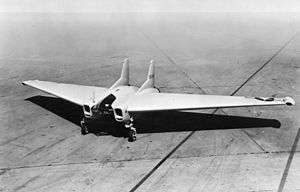Northrop XP-79
| XP-79 | |
|---|---|
 | |
| The sole prototype XP-79B. | |
| Role | Interceptor |
| Manufacturer | Northrop Corporation |
| Designer | Jack Northrop |
| First flight | 12 September 1945 |
| Retired | 12 September 1945 |
| Status | Crashed, out of service |
| Primary user | United States Army Air Forces |
| Number built | 1 |
|
| |
The Northrop XP-79 was an ambitious design for a flying wing fighter aircraft, designed by Northrop. It had several notable design features; among these, the pilot would operate the aircraft from a lying position, permitting the pilot to withstand much greater g-forces in the upward and downward direction with respect to the plane – and welded magnesium monocoque structure instead of riveted aluminum.
Design and development
In 1942, John K. Northrop conceived the XP-79 as a high-speed rocket-powered flying-wing fighter aircraft.
In January 1943, a contract for two prototypes (s/n's 43-52437 & 43-52438) with designation XP-79 was issued by the United States Army Air Forces.
To test the radical design, glider prototypes were built. One, designated MX-324, was towed into the air on 5 July 1944 by a P-38, making it the first US-built rocket-powered aircraft to fly.[1]
Originally, it was planned to use a 2,000 lbf (9 kN) thrust XCALR-2000A-1 "rotojet" rocket motor supplied by Aerojet that used monoethyl aniline and red fuming nitric acid; because of the corrosive and toxic nature of the liquids, the XP-79 was built using a welded magnesium alloy monocoque structure (to protect the pilot if the aircraft was damaged in combat) with a ⅛ in (3 mm) skin thickness at the trailing edge and a ¾ in (19 mm) thickness at the leading edge. However, the rocket motor configuration using canted rockets to drive the turbopumps was unsatisfactory and the aircraft was subsequently fitted with two Westinghouse 19-B (J30) turbojets instead. This led to changing the designation to XP-79B. After the failure of the rocket motor, further development of the first two prototypes ended.
The pilot controlled the XP-79 through a tiller bar and rudders mounted below; intakes mounted at the wingtips supplied air for the unusual bellows-boosted ailerons.[2]
Testing
The XP-79B (after delays because of bursting tires and brake problems on taxiing trials on the Muroc dry lake) was lost during its first flight on 12 September 1945. While performing a slow roll 15 minutes into the flight, control was lost for unknown reasons. The nose dropped and the roll continued with the aircraft impacting in a vertical spin. Test pilot Harry Crosby attempted to bail out but was struck by the aircraft and fell to his death. Shortly thereafter, the second prototype (43-52438) and the overall project was cancelled.
Specifications (XP-79B)
Data from
General characteristics
- Crew: one
- Length: 14 ft 0 in (4.27 m)
- Wingspan: 38 ft 0 in (11.58 m)
- Height: 7 ft 6 in (2.29 m)
- Wing area: 278 ft² (25.8 m²)
- Empty weight: 5,840 lb (2,650 kg)
- Loaded weight: 8,669 lb (3,932 kg)
- Powerplant: 2 × Westinghouse 19B turbojet, 1,150 lbf (5.1kN) each
Performance
- Maximum speed: 547 mph (880 km/h)
- Range: 993 mi (1,598 km)
- Service ceiling: 40,000 ft (12,200 m)
- Rate of climb: 4,000 ft/min (1,220 m/min)
- Wing loading: 31 lb/ft² (153 kg/m²)
- Thrust/weight: 0.27
Armament
- Guns: 4 × .50-cal (12.7 mm) machine guns (never fitted)
See also
- Aircraft of comparable role, configuration and era
- Armstrong Whitworth A.W.52
- de Havilland DH 108
- Gloster Meteor F8 "Prone Pilot"
- Horten Ho 229
- Messerschmitt Me 163
- Related lists
References
- Notes
- Bibliography
- Jenkins, Dennis R. and Tony R. Landis. Experimental and Prototype U.S. Air Force Jet Fighters. North Branch, Minnesota: Specialty Press, 2008. ISBN 978-1-58007-111-6.
- Pape, Garry and John Campbell. Northrop Flying Wings. Atglen, Pennsylvania, Schiffer Publications, 1995, ISBN 0-88740-689-0.
- Winchester, Jim. The World's Worst Aircraft: From Pioneering Failures to Multimillion Dollar Disasters. London: Amber Books Ltd., 2005. ISBN 1-904687-34-2.
External links
| Wikimedia Commons has media related to Northrop XP-79. |